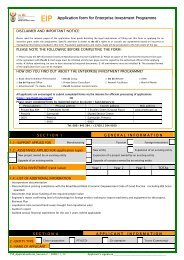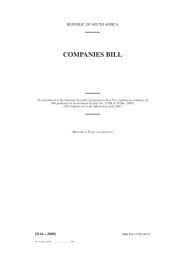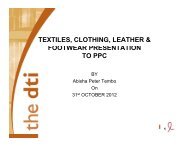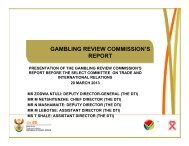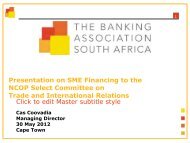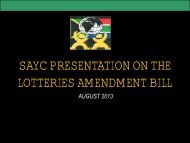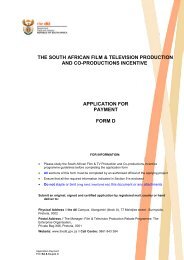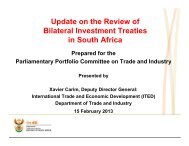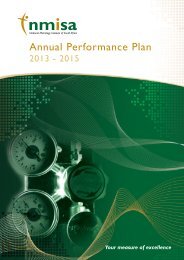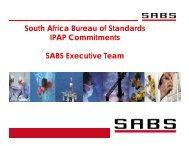Steel Pricing in South Africa: Competition history and current concerns
Steel Pricing in South Africa: Competition history and current concerns
Steel Pricing in South Africa: Competition history and current concerns
Create successful ePaper yourself
Turn your PDF publications into a flip-book with our unique Google optimized e-Paper software.
<strong>Steel</strong> <strong>Pric<strong>in</strong>g</strong> <strong>in</strong> <strong>South</strong> <strong>Africa</strong>:<strong>Competition</strong> <strong>history</strong> <strong>and</strong> <strong>current</strong><strong>concerns</strong>September 2010Towards a fair <strong>and</strong> efficient economy for all
ContentsHistory of Iscor/AMSAIssues lead<strong>in</strong>g up to the Harmony Mittal case<strong>Competition</strong> authorities decisions on the Harmony Mittal caseTests for excessive pric<strong>in</strong>g <strong>and</strong> AMSA's likely defenseComments on the <strong>current</strong> situation
History of Iscor/AMSA1927: Government established Iscor1989: Iscor privatised with significant state sharehold<strong>in</strong>g rema<strong>in</strong><strong>in</strong>gvia the IDC1996 – 1999: JV between Iscor <strong>and</strong> IDC to build Saldanha with tax<strong>in</strong>centives (S37E & S37H)2001: Unbundl<strong>in</strong>g of iron ore m<strong>in</strong><strong>in</strong>g <strong>in</strong>to Kumba <strong>and</strong> steel mak<strong>in</strong>g<strong>in</strong>to Iscor. Iscor was required to ensure the viability <strong>and</strong> costcompetitivenessof local steel production alongside a competitivepric<strong>in</strong>g regime.
History of Iscor/AMSA (cont.)2001 – 2004: LNM <strong>in</strong>troduced as an <strong>in</strong>ternational partner,<strong>in</strong>troduces efficiency improvements, <strong>and</strong> <strong>in</strong>creases sharehold<strong>in</strong>g.2004: LNM acquires majority sharehold<strong>in</strong>g <strong>in</strong> Iscor.2006: After lengthy negotiations with DTI <strong>and</strong> <strong>in</strong> the context of theHarmony Mittal case, AMSA <strong>in</strong>troduced a pric<strong>in</strong>g system based onan <strong>in</strong>ternational basket of prices.2009 – 2010: AMSA fails to convert its m<strong>in</strong>eral rights result<strong>in</strong>g <strong>in</strong> adispute over iron ore prices to AMSA by Kumba. AMSA thenimplements a price surcharge to customers deposited <strong>in</strong>to anescrow account should AMSA lose the dispute.
LNM acquisition of Iscor• LMN needed to notify the <strong>Competition</strong> Commission of a mergerwith Iscor <strong>in</strong> 2004 because it planned to <strong>in</strong>crease itssharehold<strong>in</strong>g <strong>in</strong> Iscor to above 50% (was 47.23%). The Tribunalapproved this unconditionally because it would not give rise toany substantial lessen<strong>in</strong>g of competition.• At this time the DTI had an agreement with LNM that it would:- Conclude a steel pric<strong>in</strong>g agreement with the DTI that would replaceexist<strong>in</strong>g import parity pric<strong>in</strong>g (IPP) with a susta<strong>in</strong>able, developmentalpric<strong>in</strong>g model that would raise the volumes of downstream steelbeneficiated <strong>in</strong> <strong>South</strong> <strong>Africa</strong> for both the export <strong>and</strong> domestic market <strong>in</strong>compliance with WTO (World Trade Organisation) Rules for the <strong>South</strong><strong>Africa</strong>n <strong>Steel</strong> <strong>in</strong>dustry- Increase <strong>in</strong>vestment <strong>in</strong> liquid steel capacity from 6 million tons (Mt) to 9Mt(<strong>in</strong>clud<strong>in</strong>g expansion of Saldanha <strong>Steel</strong> capacity to 2Mt from 1.2Mt).
Market StructureFlat steel productsLong steel productsAMSA 80% 52%Highveld 20% (<strong>in</strong>cl. imports) 15%Scaw 15%Cape Gate 12%Cisco 6%Scaw (Johannesburg)Highveld (Witbank)AMSA (V<strong>and</strong>erbijlpark)AMSA (Newcastle)AMSA (Saldanha)Cape Gate (Cape Town)Cisco (Cape Town)
ContentsHistory of Iscor/AMSAIssues lead<strong>in</strong>g up to the Harmony Mittal case<strong>Competition</strong> authorities decisions on the Harmony Mittal caseTests for excessive pric<strong>in</strong>g <strong>and</strong> AMSA's likely defenseComments on the <strong>current</strong> situation
Issues• AMSA enjoys a monopoly position due to it be<strong>in</strong>g a former SoE<strong>and</strong> cont<strong>in</strong>ued to enjoy preferential iron ore pric<strong>in</strong>g (cost + 3%)- AMSA's monopoly position was not "earned" by be<strong>in</strong>g moreefficient than other competitors- AMSA is not <strong>in</strong> an <strong>in</strong>novative <strong>and</strong> dynamic market- There are significant barriers to entry• AMSA pric<strong>in</strong>g at IPP to domestic customers <strong>and</strong> EPP to exportcustomers- EPP could be approximately 40% lower than IPP- <strong>South</strong> <strong>Africa</strong> is a net exporter of steel products- This was ma<strong>in</strong>ta<strong>in</strong>ed through agreements with exporters notto resell their product back <strong>in</strong>to SA
IPP pric<strong>in</strong>g by AMSAIPP pric<strong>in</strong>g by AMSA resulted <strong>in</strong> domestic customers pay<strong>in</strong>g farmore than what AMSA was able to receive on its exportsHot rolled coil steel prices – an example, US$/tSource: Iscor 2004 <strong>in</strong> DTI presentation to the Portfolio Committee of Trade & Industry, 24 Aug 2010Worldexport priceValue received on local salesAmount that localcustomers pay above whatMittal receives on exportsValue received on exports
IPP with surplus• <strong>Pric<strong>in</strong>g</strong> at IPP is not itself a contravention of the <strong>Competition</strong> Act.The issue is whether or not a competitive market would result <strong>in</strong>a lower price than IPP.- If domestic producers do not have the capacity to satisfy thedomestic dem<strong>and</strong>, then consumers will import the rema<strong>in</strong>derof what they need <strong>and</strong> the market price will be IPP.- If domestic production is greater than domestic dem<strong>and</strong> thena competitive market would lead to a domestic price close toEPP. If the market is not competitive then firms can <strong>in</strong>creaseexports <strong>and</strong> <strong>in</strong>crease the domestic price to IPP.• Situations where this distiction becomes critically important arewhere transport costs of import<strong>in</strong>g are a large proportion of thevalue of the product.
SA export volumesExports are not <strong>in</strong>cidental to AMSA’s strategy consider<strong>in</strong>g the largevolumes exported <strong>and</strong> the fact that AMSA has separate pric<strong>in</strong>gstrategies for export <strong>and</strong> domestic sales.<strong>Steel</strong> sales: domestic sales, exports, imports <strong>and</strong>embodied <strong>in</strong> value-added exports, tons ‘000Source: DTI presentation to the Portfolio Committee of Trade & Industry, 24 Aug 2010
ContentsHistory of Iscor/AMSAIssues lead<strong>in</strong>g up to the Harmony Mittal case<strong>Competition</strong> authorities decisions on the Harmony Mittal caseTests for excessive pric<strong>in</strong>g <strong>and</strong> AMSA's likely defenseComments on the <strong>current</strong> situation
Prerequisites• Excessive pric<strong>in</strong>g is tha abuse of a dom<strong>in</strong>ant position <strong>and</strong> thusthe firm has to be shown to be dom<strong>in</strong>ant.- The Act explicitly states that a firm with a market share ofmore than 45% can be presumed to be dom<strong>in</strong>ant.- The Tribunal argued that excessive pric<strong>in</strong>g requires a greaterhurdle than a 45% market share. It is necessary to show thatthe company is super-dom<strong>in</strong>ant, a "near monopoly".• Barriers to entry that cannot be overcome by potential entrantsneed to be present.- These <strong>in</strong>clude high capital costs <strong>and</strong> cost advantages from asupply agreement
Tribunal decision• The Tribunal showed that Mittal was a super-dom<strong>in</strong>ant firm thatwas uncontested <strong>and</strong> <strong>in</strong> an <strong>in</strong>contestable market.• Mittal's ancillary conduct shows that it used its dom<strong>in</strong>ance toprice excessively <strong>in</strong> the <strong>South</strong> <strong>Africa</strong>n market for flat steel. Theancillary conduct <strong>in</strong>cluded:- Segment<strong>in</strong>g markets <strong>in</strong>to domestic <strong>and</strong> export markets- Selective discounts <strong>in</strong> the domestic market to counter someconsumers ability to import, or to make steel a viable <strong>in</strong>put <strong>in</strong>production of certa<strong>in</strong> products where there are alternativeimputs.• In March 2007 the Tribunal thus found that Mittal hadcontravened Section 8(a) of the Act by charg<strong>in</strong>g an excessiveprice to the detriment of consumers.
Appeal of Tribunal decision• Dur<strong>in</strong>g the Tribunal hear<strong>in</strong>g both parties put forward evidenceon price comparisons <strong>and</strong> profitability analysis.• The Tribunal did not use these arguments as such argumentswere <strong>in</strong>formed by EC jurisprudence <strong>and</strong> the Tribunal did notwish to assume any price regulation responsibilities.• The Act however identifies that an excessive price be one whichbears no reasonable relation to the economic value of the good<strong>and</strong> is <strong>in</strong>deed higher than this economic value.• These were the grounds that led to Mittal appeal<strong>in</strong>g the Tribunaldecision <strong>in</strong> which the CAC produced a general framework toidentify excessive pric<strong>in</strong>g quantifiably.
CAC excessive pric<strong>in</strong>g test• In the Harmony Mittal appeal the CAC outl<strong>in</strong>ed the follow<strong>in</strong>gapproach to identify excessive pric<strong>in</strong>g:i. The determ<strong>in</strong>ation of the actual price at issue;ii.iii.iv.The determ<strong>in</strong>ation of the ‘economic value’, expressed asan amount of money, of the good or service;A comparison of the actual price <strong>and</strong> the economic value,<strong>and</strong> a subsequent value judgement regard<strong>in</strong>g thereasonableness or not of the relationship between the two;<strong>and</strong>,A value judgement on whether or not the charg<strong>in</strong>g of anexcessive price is to the detriment of consumers or not.
CAC decision• While the CAC set the Tribunal decision aside <strong>in</strong> September2009, it was not because the facts of the case did not supportthe decision, but rather that there was no effort to assess thecredibility of the defense that AMSA was not earn<strong>in</strong>g excessprofits.• Indeed the CAC agreed with the Tribunal that AMSA's superdom<strong>in</strong>ance,together with the ancillary conduct, did constituteprima facie evidence of excessive pric<strong>in</strong>g:"In summary, the dom<strong>in</strong>ance of Mittal read together with itscase <strong>in</strong> answer to respondent’s case, as pleaded, raised aprima facie presumption of a contravention of s 8(a)."-CAC decision, para 81
ContentsHistory of Iscor/AMSAIssues lead<strong>in</strong>g up to the Harmony Mittal case<strong>Competition</strong> authorities decisions on the Harmony Mittal caseTests for excessive pric<strong>in</strong>g <strong>and</strong> AMSA's likely defenseComments on the <strong>current</strong> situation
Comparator pric<strong>in</strong>g• Compar<strong>in</strong>g AMSA prices <strong>and</strong> costs with those <strong>in</strong> other coutriesgives an <strong>in</strong>dication of whether or not AMSA charges more than"economic value" for steel <strong>in</strong> <strong>South</strong> <strong>Africa</strong>- It is this marg<strong>in</strong> (price less the cost) that is the comparator<strong>and</strong> not the price alone- These must be on an equal quality basis• This adresses the first three steps of the CAC framework:- The actual prices charged by AMSA is step i- The comparator price is the economic value <strong>in</strong> step ii- Compar<strong>in</strong>g these two values is step iii• Another method is to compare prices charged it two differentmarkets where one market is more competitive than the other.
Comparator pric<strong>in</strong>g<strong>South</strong> <strong>Africa</strong>n prices have, for the most part, been on par withthose charged <strong>in</strong> the high price countries such as the US, Canada<strong>and</strong> the EU. Costs <strong>in</strong> SA are, however, likely to be far lower than <strong>in</strong>the these countries <strong>and</strong> closer to those <strong>in</strong> the lower price countries.Hot rolled coil prices, US$/t 2004 - 2010Source: DTI presentation to the Portfolio Committee of Trade & Industry, 24 Aug 2010
AMSA <strong>in</strong>put cost advantages• The agreement with Kumba was for iron ore on a cost plus 3%basis (approximately $35 per ton).• Even if AMSA receives iron ore from Kumba on a market basisthe price would be below the export price (approximately $147)because Kumba has export bottlenecks. This is reflected <strong>in</strong> therecent offer by Kumba of a price to Saldanha of $50 <strong>and</strong> a priceto V<strong>and</strong>erbijlpark <strong>and</strong> Newcastle of $80 (negotiated down to$70) per ton.• AMSA also enjoys cheaper electricity <strong>in</strong>put costs than othermajor steel produc<strong>in</strong>g countries. This holds even after electricityprice <strong>in</strong>creases.
AMSA price-cost cost analysis• The cost advantages, together with a high domestic price result<strong>in</strong> large profits be<strong>in</strong>g earned by AMSA• Domestic prices <strong>in</strong> SA <strong>in</strong> 2004/05 were $613 with average costsof production of $335 result<strong>in</strong>g <strong>in</strong> an gross marg<strong>in</strong> of 45%.• The expansions are expected to have led to cost reductions of$51 per tonne, thus <strong>in</strong>creas<strong>in</strong>g the gross marg<strong>in</strong> to 54%.
AMSA expansions• 2006 AMSA strategy documents <strong>in</strong>dicate plans to exp<strong>and</strong> outputby 1Mtpa by the end of 2007 <strong>and</strong> another 1.5 Mtpa by 2012.These expansions were anticipated to result <strong>in</strong> cost reductions:- A quantified target of a 20% reduction <strong>in</strong> HRC/billet cashcosts by 2007 was stated• In 2008 AMSA had <strong>in</strong>creased their expansion target to 10mt• In AMSA's 2009 annual report they stated that they hadexp<strong>and</strong>ed capacity to 8mt, but that the schedule of expansion to10mt had to be reviewed <strong>in</strong> light of market conditions. Theyrema<strong>in</strong>ed "confident [<strong>in</strong>] the long-term growth potential of the[region]" <strong>and</strong> <strong>in</strong>tent on exp<strong>and</strong><strong>in</strong>g capacity further.
“AMSA is not profitable”• Mittal has used profitability analysis to show that Mittal was notear<strong>in</strong>g excess profits. The theory beh<strong>in</strong>d this is that:- Mittal has exceptionally high fixed costs based on Mittal'svaluation of their plants,- which results <strong>in</strong> substantial economies of scale,- <strong>and</strong> export sales mak<strong>in</strong>g a partial contribution to fixed costsbut not to profits.- "Mittal's dual-pric<strong>in</strong>g system is a bus<strong>in</strong>ess imperative"– Mittal claim as reported <strong>in</strong> Eng<strong>in</strong>eer<strong>in</strong>g News, 15 March 2006• This practical application by AMSA was disputed <strong>in</strong> the case,however never resolved. AMSA ma<strong>in</strong>ta<strong>in</strong>s that its plants are nothighly profitable.
AMSA profitability• Profits slumped <strong>in</strong> 2009 but have begun recover<strong>in</strong>g at the endof 2009 <strong>and</strong> <strong>in</strong>to 2010AMSA Quarterly Headl<strong>in</strong>e Earn<strong>in</strong>gs, 2005 – Q2 2010Source: AMSA <strong>in</strong>terim results 20102009 losses were partially due toimports of steel slabs dur<strong>in</strong>g theexpansions to keep the roll<strong>in</strong>g millrunn<strong>in</strong>g. As these expansions comeonl<strong>in</strong>e profits recover.
ContentsHistory of Iscor/AMSAIssues lead<strong>in</strong>g up to the Harmony Mittal case<strong>Competition</strong> authorities decisions on the Harmony Mittal caseTests for excessive pric<strong>in</strong>g <strong>and</strong> AMSA's likely defenseComments on the <strong>current</strong> situation
AMSA’s s basket pric<strong>in</strong>g• AMSA implemented a basket pric<strong>in</strong>g approach <strong>in</strong> March 2006which is based <strong>in</strong> theory on comparator prices.- AMSA's basket is a simple average of 6 countries, 3 of whichare higher cost than SA (US, Europe, Russia) <strong>and</strong> 3 of whichare lower costs than SA (Ch<strong>in</strong>a <strong>and</strong> 2 develop<strong>in</strong>g countries)- AMSA may also manually modify the basket price frommonth to month based on dem<strong>and</strong> <strong>and</strong> supply conditions• Ultimately it not clear whether or not the basket pric<strong>in</strong>gimplemented by AMSA has resulted <strong>in</strong> pric<strong>in</strong>g <strong>in</strong> l<strong>in</strong>e witheconomic value. Furthermore, facts presented to DTI by AMSAmay not be fully reflective of the actual pric<strong>in</strong>g framework giventhat they were even "prepared to blatantly mislead the Tribunalon [the implimentation of basket pric<strong>in</strong>g by AMSA]."(Harmony Mittal Tribunal decision, para 46)
The AMSA surcharge• Dur<strong>in</strong>g the dispute with Kumba AMSA applied a surcharge ontop of the basket price to customers- The basket would have <strong>in</strong>cluded the iron ore costs ofsuplliers <strong>in</strong> the foreign countries. AMSA apply<strong>in</strong>g a surchargeto the basket may be <strong>in</strong>terpreted as partially double count<strong>in</strong>giron ore <strong>in</strong>put costs?• The theory on excessive pric<strong>in</strong>g requires that a firm charge anexcessive price <strong>in</strong> the long term. The surcharge was, however,only imposed for a few months.• The ability to unilaterally impose a surcharge on goods doeshowever give good <strong>in</strong>sight <strong>in</strong>to the degree of AMSA's dom<strong>in</strong>ance
Current steel cases at the CCAbuseCartelInvolv<strong>in</strong>gMittalNot<strong>in</strong>volv<strong>in</strong>gMittal



